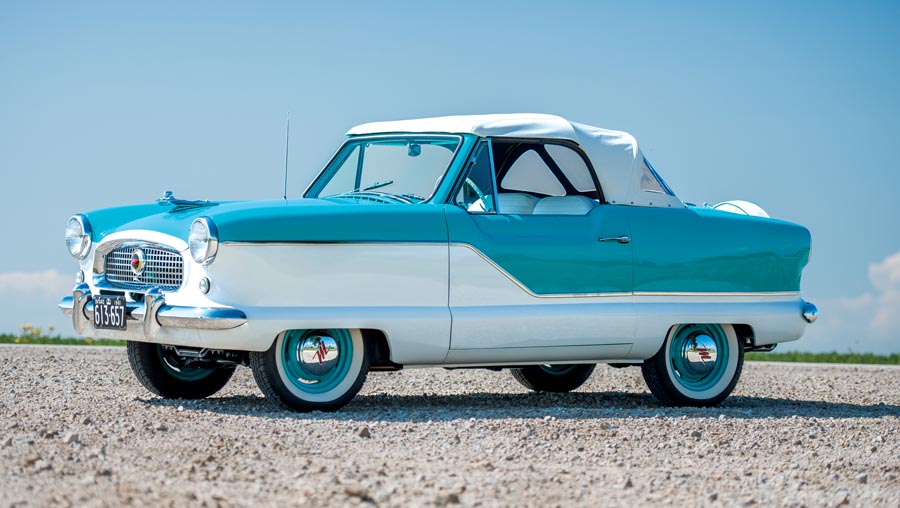SCM Analysis
Detailing
| Vehicle: | 1961 AMC Metropolitan Convertible |
| Years Produced: | 1953–61 |
| Number Produced: | 94,968 |
| Original List Price: | $1,697 |
| SCM Valuation: | $17,600 |
| Tune Up Cost: | $250 |
| Chassis Number Location: | Tag on firewall, right upper shock tower |
| Engine Number Location: | Tag on right side of engine |
| Club Info: | Metropolitan Owners Club of North America |
| Website: | http://mocna.us |
| Alternatives: | 1950–59 Volkswagen Beetle, 1958–59 Opel Rekord, 1958–59 Fiat 500 |
| Investment Grade: | B |
This car, Lot 233, sold for $74,250, including buyer’s premium, at RM Sotheby’s auction at Hershey, PA, on October 5–6, 2017.
It takes a committed visionary to go against the tide of conventional wisdom, and George Mason, president of Nash-Kelvinator, was such a man.
While the majority of automotive manufacturers wallowed in the car-buying frenzy that resulted from the pent-up demand at the end of World War II, Mason saw that this euphoria would be short-lived.
As the population migrated to the suburbs, Mason knew that people would need a smaller, inexpensive second car for the family, and this was the market he set his sights on.
Enter the NXI
The Nash Rambler, with a 100-inch wheelbase, was introduced in 1950, but Mason was convinced there was a market for an even smaller car. A prototype called the NXI — Nash Experimental International — was developed, based on independent designer Bill Flajole’s design.
Flajole’s design was well received, but price was a major consideration. Mason realized the car could not be built in America at a competitive production cost, so he looked for a European partner.
It came down to Fiat and Austin, with the latter selected. The body was to be built by Fisher & Ludlow Ltd., with final assembly and the 42-horsepower A-40 engine from the Austin Motor Company.
The car was introduced in March 1954 — with a retail price of $1,469 for the convertible and $1,445 for the coupe.
The initial response was enthusiastic, with over 11,000 orders placed in 1954.
Super product placement
Now, George Mason was a true master of marketing. He managed to get the 112-horsepower Nash Ambassador 4-door sedan, which he drove, selected as the pace car for the 1947 Indianapolis 500.
He also arranged for Nash products to be prominently featured in the popular “Superman” TV series. Clark Kent, aka Superman, often drove a Nash-Healey. His girlfriend, Lois Lane, appeared in a Rambler, and photographer Jimmy Olsen drove a Metropolitan.
Time passed, and sales faltered, which meant a redesign was in order for the 1956 model year.
The larger Austin A-50 engine, which produced 52 horsepower, was utilized. Distinctive zig-zag chrome side moldings became the car’s trademark.
The Metropolitan was now sold by both Nash and Hudson dealers, with the only difference being the grille badging. However, both names were gone by 1958, when AMC dropped the Nash and Hudson brand names. The little Metropolitan, however, motored on.
“Luxury in Miniature”
A trunk was added in 1959, and Metropolitans were advertised as “Luxury in Miniature.” Sales were at an all-time high, with 22,209 Mets leaving dealer showrooms.
Production was ramped up for the anticipated sales increase that never happened. Why not? Small, imported European cars such as the Volkswagen, MG and Opel were now dominating the market.
The Metropolitan was discontinued in the middle of 1960, but sales continued as late as 1963, as the cars were retitled to the appropriate year.
The last 412 Metropolitans were delivered in 1962, and the little car became a footnote in automotive history.
Too much for an exceptional example
Our subject Metropolitan was built in June of 1960 and was one of 114 shipped to Canada in 1961. It was restored to an exceptional standard and finished in the correct livery of P 912 Berkshire Green with P 914 Frost White.
The trim code was listed as T-1, however, which is correct for cars built through 1955, with code T-921 being correct for this car.
This car sold for over-the-top money, as at least two spirited bidders decided they had to have the car regardless of common sense.
There are 249 Metropolitans listed in the ACC Premium Auction Database, with only two selling in the $50,000 range. Most of the cars in the database sold for under $15,000.
This car was an outlier by a wide margin.
The sale of the famed Bruce Weiner microcar collection in February 2013 seemed to legitimize little cars, and we have seen numerous unusual examples sell for six figures.
Close to 100,000 Metropolitans were produced, however, so they are far from rare. They are not a difficult restoration. With that said, it’s difficult to justify the price paid here. I have to think the underbidder is breathing a sigh of relief.
(Introductory description courtesy of RM Sotheby’s.)
